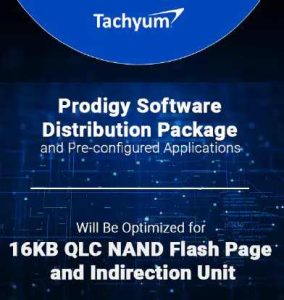Tachyum Targets 16KB QLC NAND Flash Page and Indirection Unit
Prodigy software distribution package and pre-configured applications will be optimized for 64KB pages for Linux and 16KB Indirection Unit for SSDs in advance of QLC NAND flash eventual replacement for HDDs in data center.
This is a Press Release edited by StorageNewsletter.com on July 15, 2024 at 2:01 pmTachyum, Inc. announced that the Prodigy software distribution package and pre-configured applications will be optimized for 64KB pages for Linux and 16KB Indirection Unit (IU) for SSDs in advance of QLC NAND flash eventual replacement for HDDs in the data center.
This achievement ensures that Prodigy-enabled systems will support future QLC NAND flash, networking requirements and make 16KB storage networking stack much more efficient for 1.6T Ethernet in servers.
Tachyum storage technology supports CEPH, an open-source software storage platform that is being optimized for 64KB pages and 16KB IU SSDs. With future networking expected to enable jumbo frames (9,000-9,216B) and potentially super jumbo frames (17KB), the company’s optimization satisfies the reliability and high-performance needs while reducing costs.
Real-world SSD IU testing shows that these workloads allow more efficient data granularity and enable very large SSD capacities. While SSD is only twice as expensive as HDD today, QLC reduces costs further but has lower endurance. Moving from 4KB Low-Density Parity Check (LDPC) error correction to 16KB improves QLC reliability considerably.
Flash pages have already moved to 16KB. The 16KB IU reduces DRAM need for high performance SSD by a factor of 4. The 32TB SSD would need 32GB of DRAM, which is large and expensive with 4KB IU but only 8GB on a single 32GB DDR5 dual-die package of 2 DRAM chips. Kioxia and WD just unveiled a 2Tb QLC die delivering 4TB in a 11.5×13.5×1.5mm package. With next year’s 420-plus layer NAND die, Samsung will also likely be moving to a 2Tb die, and nothing prevents Micron from introducing a 2Tb die within the year, followed by SK Hynix and YMTC. The increased density will drive 16TB E1.S SSDs to become a volume product by next year.
The 2Tb QLC flash will double storage system capacity at the same power and in the same footprint. The 2Tb die will reduce the cost/GB of flash storage systems, since the unchanged cost of storage systems excluding flash will be amortized against the doubled flash storage capacity, delivering 2x higher capacity at the same cost. In addition, as we continue our analysis of industry trends, the company expect 4Tb QLC die to be feasible next year, making today’s 4KB IU unsustainable and forcing the transition to 16KB IU, with Prodigy fully prepared for the transition.
“Tachyum has core SandForce and Skyera team members who are experts in NAND flash storage,” said Dr. Radoslav Danilak, founder and CEO, Tachyum. “The Tachyum engineering team previously delivered SandForce flash controllers, as well as storage appliances at Skyera with compression, so extending this technology to data center level is simply evolutionary for the team. This ensures Prodigy will be able to handle the toughest workloads not only today but into the future as well.”
As a Universal Processor offering industry performance for all workloads, Prodigy-powered data center servers can dynamically switch between computational domains (such as AI/ML, HPC, and cloud) with a single homogeneous architecture. By eliminating the need for expensive dedicated AI hardware and increasing server utilization, Prodigy reduces Capex and Opex significantly while delivering unprecedented data center performance, power, and economics. Prodigy integrates 192 high-performance custom-designed 64-bit compute cores, to deliver up to 4.5x the performance of the highest-performing x86 processors for cloud workloads, up to 3x that of the highest performing GPU for HPC, and 6x for AI applications.














 Subscribe to our free daily newsletter
Subscribe to our free daily newsletter

